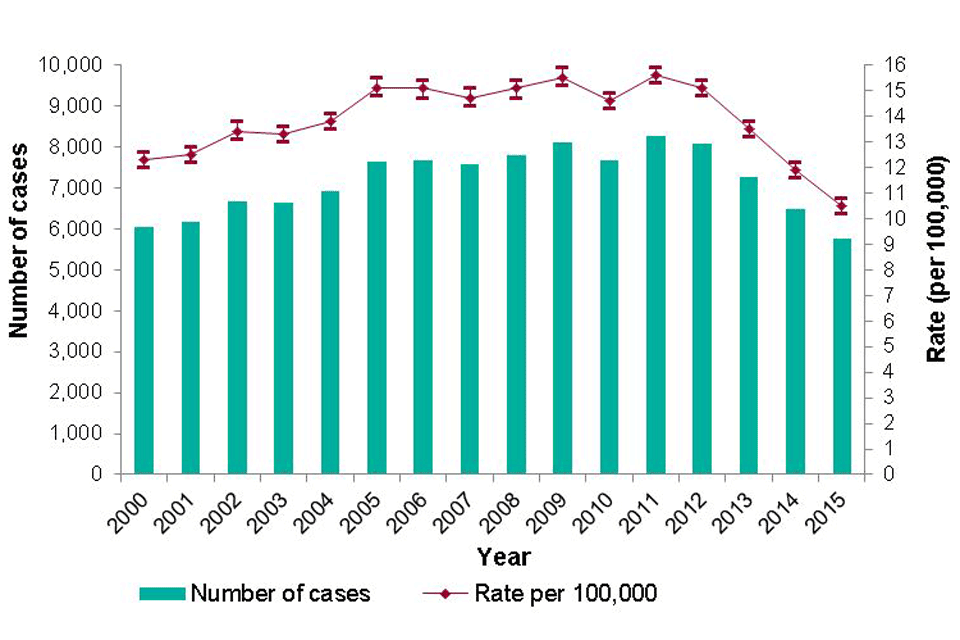HPR volume 10 issue 33: news (30 September)
Updated 16 December 2016
1. Annual report on tuberculosis in England 2016
In January 2015, PHE and NHS England launched the Collaborative Tuberculosis Strategy for England 2010 to 2020 [1]. This week, PHE published the Tuberculosis in England 2016 report, which describes the epidemiology of TB in England since the launch of the strategy, and provides data on the implementation of the UK pre-entry TB screening programme, the national roll-out of systematic latent tuberculosis infection (LTBI) testing and BCG vaccination coverage estimates. On the basis of the data presented, recommendations are made on the further work required to deliver the aims of the strategy and, ultimately, lead to improved TB control in England [2].
It is encouraging to see that there has been a year-on-year decline in the incidence of TB in England over the past 4 years, down to 10.5 per 100,000 (5,758 cases) in 2015 (Figure 1). This represents a decline of one-third since the peak incidence of 15.6 per 100,000 (8,280 cases) in 2011. This is the lowest TB incidence in England since the start of enhanced TB surveillance in 2000 (Figure 1). In the past year, the decline in the number of TB cases has been seen in both the non-UK born and UK born populations, and in all PHE Centres. However, the rate of TB in the non-UK born population is still 15 times higher than in the UK born population, and 73% of cases were non-UK born.

Graph showing TB case notifications and rates in England from 2000 to 2015
The recent decline in the incidence of TB in England is likely due to a combination of the impact of UK pre-entry TB screening (which identified 382 cases of active pulmonary TB in 2015), a reduction in the number of new migrants from high TB burden countries, improvements in TB control leading to a reduction in transmission, and the early impact of testing and treating LTBI.
Following a year-on-year improvement, there has been a slight reduction in the proportion of TB cases (with an expected treatment duration of less than 12 months) who had completed treatment by 12 months, from 85.4% of cases notified in 2013 to 84.5% of cases notified in 2014. This was mainly due to a small increase in the proportion of cases who had died, from 4.1% to 4.8%.
The number and proportion of TB cases with multi-drug resistance/rifampicin resistance (MDR/RR-TB) has decreased since the peak of 89 cases in 2011; there were 54 cases (1.6%) notified with initial MDR/RR-TB in 2015. However, 10 of these cases had extensive drug resistance (XDR-TB), for which there are fewer treatment options and more complex management is required.
In 2015, there was a small reduction in the proportion of non-UK born cases who experienced a delay of more than 4 months from date of reported symptom onset to treatment start. However, long delays are still reported, with over a quarter of non-UK born pulmonary cases and over a third of UK born pulmonary cases having a delay of more than 4 months in 2015.
Despite the reduction in overall TB cases in the past 4 years, the number of cases with social risk factors (homelessness, drug or alcohol misuse or imprisonment) has not declined. The proportion of cases with at least one of these risk factors increased from 9.8% in 2014 to 11.8% in 2015. TB cases in those with social risk factors are more likely to have pulmonary disease and drug resistance, and have worse TB outcomes; those notified in 2014 with at least one social risk factor were twice as likely to have died or be lost to follow-up after 12 months compared to cases without a risk factor.
To continue to achieve the ambitions of the Collaborative TB Strategy for England, a year-on-year reduction in TB incidence, and the eventual elimination of TB as a public health problem in England, sustained work is required to deliver all of the 10 key areas of action which are set out in the strategy. Specifically, it will be important to focus on:
- reducing TB among migrants through LTBI testing and treatment
- reducing diagnostic delay through awareness raising and improving accessibility of services
- maintaining the quality of TB treatment and care services to ensure continued high treatment completion
- addressing the social factors associated with TB, including the specific needs of under-served populations
1.1 References
- Public Health England (2015). Collaborative tuberculosis strategy for England 2015 to 2020.
- Public Health England (2016). Tuberculosis in England: 2016.
2. Vaccine coverage and vaccine-preventable disease reports in this issue of HPR
The following reports are published in this issue of HPR. The links below are to the relevant webpage collections.
